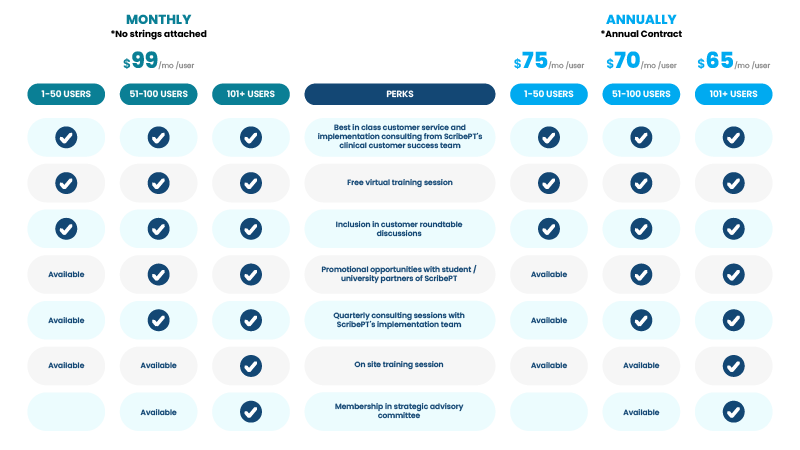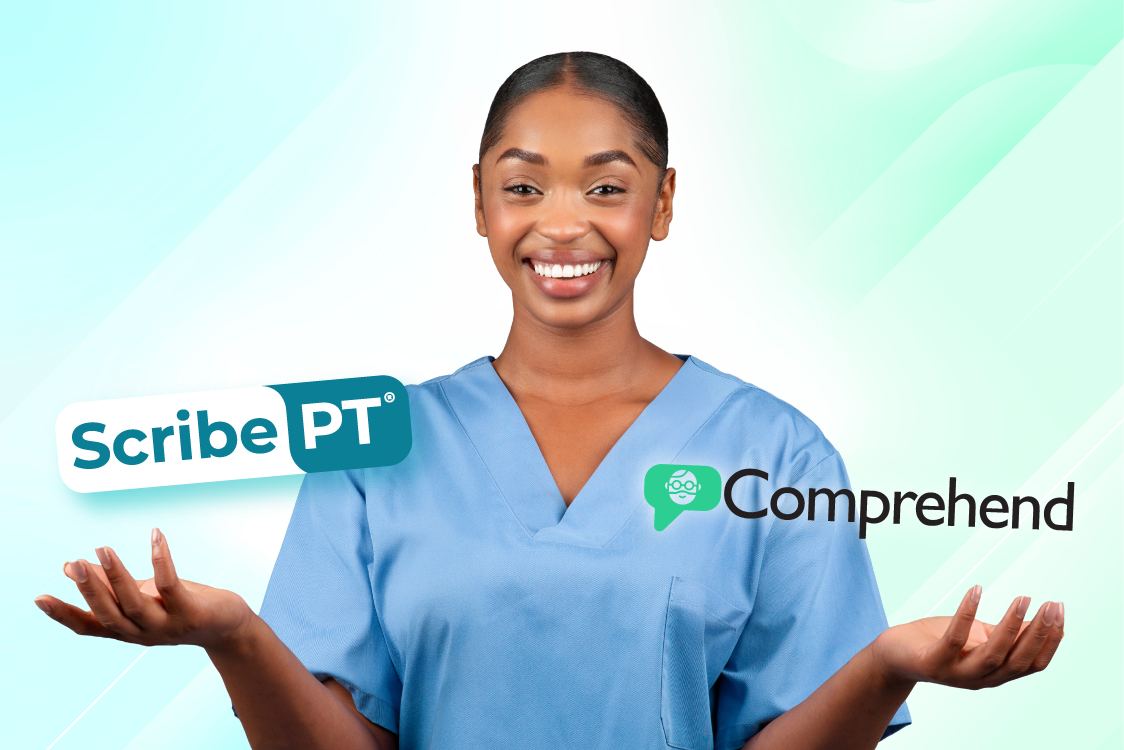Highlights
ScribePT is purpose-built for rehab therapy, focusing on specialized documentation, real-time transcription, and seamless EMR integration, while Comprehend offers a more general-purpose approach suitable across diverse clinical settings.
ScribePT’s AI is specifically trained on rehab language and workflows, reducing manual edits and improving documentation accuracy, whereas Comprehend’s broader model may require more post-session adjustments for therapy-specific nuances.
Both platforms offer free trials, but ScribePT's tailored demo experience for rehab professionals provides a deeper evaluation of its fit within therapy-specific documentation styles and workflows.
Rehab therapy isn’t like any other field in healthcare. The conversations are different and the workflows are unique. From personalized care plans to goal-driven progress notes, the documentation demands are relentless and highly specialized. That’s why choosing an AI medical scribe isn’t just about automation or voice recognition. It’s about finding a solution that truly gets the way rehab professionals work, think, and care.
ScribePT and Comprehend both promise to lighten the load of clinical documentation, but beneath the surface, their differences are distinct. One is purpose-built with rehab therapists in mind, the other takes a broader approach. One focuses on fewer clicks, seamless integration, and clinically relevant notes, while the other leans into general AI capabilities. So, which one really delivers for physical, occupational, and speech therapists?
In this blog, we’ll break down the key differences between ScribePT and Comprehend to help you make the best choice for your clinic or practice. Whether you're a solo PT, part of a busy outpatient team, or managing a growing therapy group, this side-by-side comparison will help you find the AI medical scribe that’s not just smart, but also rehab smart. Let’s dive in.
Company Background
Before diving into features and performance, it’s essential to explore the roots of ScribePT and Comprehend. By understanding where each platform comes from, we can better understand how well it aligns with the real-world needs of rehab professionals.
ScribePT
Founded with a mission to transform the healthcare experience for both patients and providers, ScribePT was born from the firsthand frustrations of physicians overwhelmed by documentation demands. What began as a solution to the growing frustrations with cumbersome electronic health record systems has evolved into a leading-edge AI medical scribe platform trusted by healthcare providers across the country. Built by a team of therapists, ScribePT is rooted in a deep understanding of the clinical workflow and the real-world challenges practitioners face every day.
With a focus on precision, usability, and seamless integration, ScribePT uses advanced AI to capture and document patient encounters in real time—accurately, securely, and with minimal disruption. The platform is designed to feel like a natural extension of the provider’s workflow, helping to reduce administrative burnout while improving documentation quality and patient engagement. As healthcare moves toward smarter, more connected systems, ScribePT continues to lead the charge—empowering clinicians to do what they do best: deliver exceptional care.
Comprehend
he idea behind Comprehend started with a familiar scene in healthcare: a therapist spending a holiday evening catching up on documentation instead of spending time with family. That moment highlighted a deeper issue, which is the administrative burden stealing time from both clinicians and patients. It sparked a vision of a future where AI could handle such tasks, and predicted that one day AI would take over.That vision became the foundation for Comprehend.
Today, Comprehend is an AI-powered medical scribe designed to automate documentation by capturing natural clinical conversations and generating structured notes in real time. With features like EHR integration, speech recognition, and customizable templates, it supports a wide range of healthcare providers. While it has begun expanding into therapy settings, its core design is generalized, which may require additional tailoring for the specific workflows and language used in rehab disciplines like physical, occupational, and speech therapy.
Core Features Comparison
The capabilities of each AI medical scribe solution matter greatly, especially when considering EMR integration, documentation style, and how recording is handled. To make a well-informed decision, it’s critical to understand what each solution offers and where the differences matter.
Here’s a head-to-head breakdown of the most important features:
 |
||
|---|---|---|
| Monthly Cost | $75 | $91 |
| Setup Fee | $0 | $0 |
| Month-to-month Contract | ||
| Free Trial | 4 weeks | 1 week and automatically billed after 7days |
| Audio Recording Limit | Unlimited | |
| AI Documentation Scribe | Full Note | Full Note |
| Real-Time Custom Compliance Checks | ||
| Fully Customizable One-Click Paste-to-EMR | ||
| Personalized Documentation (looks like you wrote it) | Must be managed by each individual user |
|
| Produces Speaker-tagged Session Transcripts | ||
| Ownership Structure | Privately Owned (Customer-centric company with a 25-year history of success |
|
| Long-Term Dedication to Serving Rehab Therapists | ||
| All Account Managers are Licensed Therapists |
Technology & Accuracy
Not all AI scribes speak the same language. In rehab therapy, you’re not just tossing out generic medical terms. You’re talking functional goals, movement patterns, patient behaviors—all while staying on track with billing codes and documentation standards. The right technology should be able to follow your pace, understand your terminology, and produce notes that reflect the depth of your care without missing a beat.
This section dives into the core technology behind ScribePT and Comprehend. We’ll explore how each platform processes speech, handles therapy-specific language, and delivers accurate documentation that’s either ready to go—or in need of fixing. Because at the end of the day, accuracy isn’t optional, it’s the difference between saving time and adding more work.
Types of AI/ML used
ScribePT utilizes a hybrid AI approach combining specialty-trained large language models (LLMs) with context-aware automatic speech recognition (ASR). These systems are continuously trained on rehabilitation-specific data, such as SOAP notes, goal-setting language, and clinical assessment phrasing. With that being said, ScribePT’s technology allows deep understanding on the subtleties of therapist-patient interactions, including nuanced terminology across physical, occupational, and speech therapy domains.
Additionally, ScribePT incorporates a feedback loop mechanism where therapist corrections feed back into the model, improving its accuracy over time on an individual and global level.
Comprehend, on the other hand, utilizes general-purpose ambient AI technology designed to work across a broad range of clinical settings. It leverages large language models (LLMs), voice recognition, and NLP to convert spoken dialogue into accurate documentation. While this allows Comprehend to perform well in many environments, its models are not specialized for rehab-specific use. As a result, it may require more manual edits to capture therapy-specific terms, goal tracking, or nuanced observations. Its flexibility is a strength, but in highly specialized fields like rehab, this broad approach can come at the expense of precision.
Accuracy of Transcriptions and Notes
ScribePT is built to mirror the unique language and flow of rehab therapy sessions, which directly contributes to its high transcription and note accuracy. It is trained on therapist-led conversations and documentation styles, which enables it in capturing clinical intent, functional goals, and SOAP note structure with minimal edits required. Therapists using ScribePT often report that the notes are nearly ready to sign, saving them time and reducing cognitive load at the end of the day. This level of precision isn’t just convenient—it helps ensure compliance, billing accuracy, and better continuity of care.
Comprehend, while capable of generating accurate transcriptions in general medical settings, may fall short in therapy-specific scenarios. Its notes can be clear and coherent, but without deep familiarity with rehab language—like mobility scales, treatment progression, or discipline-specific abbreviations—important clinical nuance can be missed or misrepresented. This often leads to extra time spent reviewing and editing, which limits the overall time-saving benefit. For practices outside of general medicine, especially in rehab, accuracy isn’t just about transcription—it’s about understanding what matters in the note.
User Control Over Output
When it comes to documentation, accuracy is important—but so is control. Both ScribePT and Comprehend recognize that clinicians don’t want to hand over everything to automation. That’s why each platform allows users to guide how the final note looks and feels. Whether it's adjusting phrasing, reorganizing sections, or adding important clinical details, users are given the flexibility to make the documentation truly their own. This balance of automation and human oversight helps ensure notes stay clinically sound and personally tailored.
Each platform approaches this control a little differently. Some offer editable templates, real-time note previews, or voice commands to fine-tune documentation as it’s being captured. Others allow for post-session editing with smart suggestions built in. Regardless of the method, the goal is the same: to give therapists a level of ownership over their documentation without forcing them to start from scratch. In environments where every note matters, that level of input can make a big difference in both confidence and compliance.
Ease of Use
When it comes to choosing an AI scribe, even the most powerful features won’t matter if the tool is clunky, confusing, or slows you down. As a therapist, your focus should be on your patients, not on wrestling with software. That’s why ease of use isn’t just a “nice-to-have”—it’s essential. A good AI scribe should feel like a natural extension of your workflow, not an extra task to manage. From setup to daily use, the right platform should save you time, reduce friction, and help you get through your clinical notes with less effort and more confidence.
Interface and Workflow Integration
A user-friendly interface and seamless workflow integration are key when adopting any AI scribe. Both ScribePT and Comprehend understand that therapists don’t have time to wrestle with complex systems. Their platforms are designed to fit into existing clinical routines, aiming to reduce friction rather than add steps.
ScribePT offers an interface built to align with rehab-specific workflows, focusing on simplicity and minimal clicks. Its design emphasizes real-time use during sessions, with features that allow for quick edits and structured documentation that mirrors therapy notes. Comprehend, meanwhile, emphasizes flexibility with a clean, modern layout that adapts to various clinical settings. It provides intuitive tools for reviewing and modifying generated notes and supports integration with commonly used EHR systems. Both platforms aim to streamline documentation without disrupting patient care, though their approaches vary depending on user needs and clinical environments.
Onboarding Experience
No one has time for a complicated setup. The sooner you can hit the ground running, the better. Both ScribePT and Comprehend get that, which is why their onboarding experiences are built to be smooth, simple, and stress-free.
ScribePT walks you through the essentials with a focus on real rehab scenarios, helping therapy teams feel at home with the platform from the start. Comprehend takes a flexible approach, offering tools and support that adjust to your practice’s pace—whether you're tech-savvy or just getting comfortable. In both cases, the learning curve is minimal, the guidance is clear, and the goal is the same: get you up and document without missing a
Pricing & Plans
Pricing can be a key factor when choosing an AI scribe, especially for practices balancing efficiency and budget. This section compares the general pricing models, subscription options, and availability of free trials or demos for ScribePT and Comprehend.
General Pricing Structure
ScribePT offers a straightforward monthly subscription pricing model, which includes all core features like AI-powered note generation, real-time transcription, and seamless EMR integration. This predictable pricing is ideal for solo practitioners or small clinics who prefer simplicity and transparency. ScribePT also provides a free trial or demo period, allowing you to test the platform before committing.

Ready to level up your documentation? Check out ScribePT’s simple, all-in pricing and see the value for yourself!
Comprehend, by contrast, offers a broader pricing structure that reflects its multi-specialty capabilities. While robust, it may include features less relevant to rehab, making the investment harder to justify for therapy-focused teams.
Free Trials/Demos
Both ScribePT and Comprehend offer free demo experiences, giving clinics a chance to explore the platform before making a commitment. These trials allow providers to test how each system performs in real-world scenarios, which includes how it captures conversations, structures notes, and integrates into the day-to-day workflow.
Where ScribePT stands out is in how tailored its demo experience feels. It’s built around rehab-specific use cases, allowing therapists to truly evaluate how well the tool fits their documentation style and clinical flow. Comprehend’s demo provides a broader overview of its capabilities, which is helpful for general use, but may not dive as deeply into the nuances of therapy-specific documentation.
Final Verdict
At first glance, both ScribePT and Comprehend aim to solve the same problem: reducing the weight of clinical documentation through the power of AI. And in many ways, they both succeed. Comprehend brings a flexible, capable system that can adapt across a variety of clinical settings, which makes it a solid option for healthcare teams looking for streamlined support.
But when you step into the unique world of rehab therapy, the bar is higher. Documentation here isn’t just about capturing what was said. It’s about reflecting goals, tracking nuanced progress, and aligning with treatment plans that evolve in real time. That’s where ScribePT consistently rises above. Purpose-built for physical, occupational, and speech therapists, it delivers not just convenience but clarity with notes that feel like they came straight from your own clinical voice, without the extra clicks or corrections.
If your work lives in rehab, your AI scribe should too. While both tools show promise, ScribePT proves it’s not only ready for the complexities of therapy, it was built for them.
Trusted by providers across the country, ScribePT leverages cutting-edge AI to simplify clinical documentation, saving healthcare providers time and reducing administrative stress. With real-time transcription and seamless integration into existing EMR/EHR systems, it’s designed to enhance productivity without disrupting your workflow. Take advantage of ScribePT’s next-generation AI and save up to 40+ hours a month on patient documentation.

